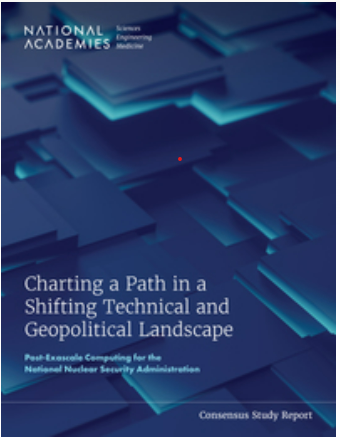 Post-exascale supercomputing for the NNSA (National Nuclear Security Administration) is the subject of a new report by a distinguished review committee comprised of notable supercomputing experts, three of whom presented their findings at a webinar last week. Among other observations Shahin and Doug came away with is that those responsible for guiding U.S. supercomputing leadership on the global stage are under relentless pressure, in an increasingly challenging environment, to make mistake-free, long-term strategic choices. Their task is like that of Sisyphus, except the boulder never rolls down the mountain, it must eternally be pushed up. As one of the panelists — Dan Reed of the University of Idaho — said, “in supercomputing, these are the best of times and the worst of times.”
Post-exascale supercomputing for the NNSA (National Nuclear Security Administration) is the subject of a new report by a distinguished review committee comprised of notable supercomputing experts, three of whom presented their findings at a webinar last week. Among other observations Shahin and Doug came away with is that those responsible for guiding U.S. supercomputing leadership on the global stage are under relentless pressure, in an increasingly challenging environment, to make mistake-free, long-term strategic choices. Their task is like that of Sisyphus, except the boulder never rolls down the mountain, it must eternally be pushed up. As one of the panelists — Dan Reed of the University of Idaho — said, “in supercomputing, these are the best of times and the worst of times.”
The report, “Charting a Path in a Shifting Technical and Geopolitcal Landscape,” examines the trajectory of leadership-class supercomputing to date, future needs, emerging technologies, advances in scientific disciplines and computational methods, workforce development, industry partnerships, the roles of AI and quantum, barriers and potential pitfalls and the roadmap for successful deployment.
We bring you a summary and commentary on the report’s key findings. We also note, happily, that two of the panelists, Reed and Kathy Yelick of Cal Berkeley, have been @HPCpodcast guests.
You can find our podcasts at insideHPC’s @HPCpodcast page, on Twitter, at the OrionX.net blog, on iTunes, and on Google. Here’s the OrionX.net podcast page, and the RSS feed.
We welcome your ideas for special topics and guest commentators. Feel free to contact Doug Black or Shahin Khan with your suggestions.




